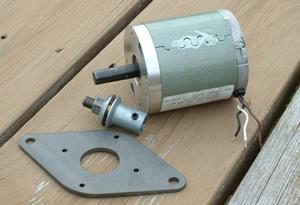
A wind generator is basically an electric motor turned upside down and backwards. An electric motor uses electromagnetic principles and forces to turn electric current into motion, driving a car, chopping up food, spinning a clothes dryer, or otherwise doing work.
A wind turbine does the same thing in reverse. Using principles of electromagnetism, it converts motion into electric current. The motion to generate electrical power can be supplied by steam power from water heated by burning fuel or nuclear reactions, or it can come from the natural motion of water (hydroelectric power) –
Wind Turbine Design
The design of commercial wind turbines is built around a number of limiting parameters. These include maximum and minimum operating temperature and maximum wind speed beyond which the turbine will be destroyed by wind shear. In addition, a wind turbine is
designed to generate maximum power at varying wind speeds, rather than merely for maximum operation in high winds. This is because the wind does not blow at a constant speed even at its most reliable.
For all of these reasons, the construction of a wind turbine is not a simple thing. Although a wind generator is an electric motor operating in reverse, it has a different mission than a motor. A motor receives a constant level of electric current and translates that into a varying amount of motion, while a wind turbine receives a varying amount of motion and translates that into the maximum electric current it can. Because of this different mission, it requires different design parameters.
Purchasing Wind Generators
Wind generators may be bought for home use, as part of a home electrical system, from Amazon, eBay, the Home Depot, and other sources. It’s not hard to find turbines of varying capacity through a simple web search. The price usually varies from $1 to $3 per kilowatt capacity, but better deals can be found with some effort. This cost does not include the labor to install it, or the ancillary equipment necessary to turn it into a home energy system.
Building A Wind Generator From A Motor
Granted that using a motor to generate electricity by connecting it to a set of rotor blades in the wind will not produce optimum results (not really good enough to power a home energy system), it can still be done and generate current for other purposes. One can see the way a wind turbine works, and use it to power electrical toys or to recharge batteries. In selecting a motor for the purpose, the best choice is one that operates at low revolutions per minute (RPM). This is not idea for motor purposes, but it means that the amount of current that can be produced with a given speed of spin is high. Older motors are better for the purpose than newer ones, and odds are you will be purchasing your motor used.
The next step is to create a set of turbine blades and attach it to an axis of rotation going through the motor itself. You can find some fairly good designs for this online. Making turbine blades from PVC piping is a good approach, as the material is inexpensive, lightweight, and easy to work with. Again, this will not produce a wind generator that is very good for home electricity generation –
